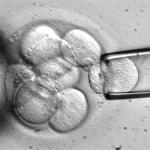Human-Animal Hybrid Ban Goes Too Far
 On April 29, the Arizona legislature approved A new law banning the creation of "chimeras"--human-animal hybrids. While it sounds like Science Fiction, the issue is real.
On April 29, the Arizona legislature approved A new law banning the creation of "chimeras"--human-animal hybrids. While it sounds like Science Fiction, the issue is real."An anything, a nothing, a fancy, a chimera in my brain, troubles me in prayer"
-- John Donne
On April 29, the Arizona legislature approved a new law banning the creation of "chimeras"--human-animal hybrids. The new law prohibits any resident of Arizona from “creating or attempting to create an in vitro human embryo by any means other than fertilization of a human egg by a human sperm.” Some Democrats are chuckling at what they believe is a legislature that has gone out of its skull, but the issue that is being raised is real.
In recent years, scientists have started to create actual chimeras -- hybrid life forms that contain genetic material from both humans and animals. That opens up the disturbing possibility of true human-animal genetic hybrids.
There have already been some early successes. In 1984, scientists at the Institute of Animal Physiology in Cambridge, England created a "geep"--a goat-sheep hybrid. In 2003, in China, human cells were fused into rabbit embryos, creating human-rabbit hybrids. (These developed for a few days before being destroyed.) In 2005, at Stanford University, scientists infused human embryonic stem cells into the brains of mouse fetuses, creating mice with human cells in their brains. (Scientists hope to tailor their research to treat diseases such as Alzheimer's.) And in 2007, scientists at the University of Nevada created a sheep, 15% of whose cells were human.
But the infusing of human brain cells into an animal host poses obvious ethical problems. What if a mouse could be grown whose brain is mostly made of human cells? Is this a human brain? What if cells from an animal's brain were implanted into the brain of a developing human embryo? And a baby was born whose brain was partly animal?
Could a human-animal chimera be patented, as have other genetically tailored life forms? Would such a patent be in violation of the 13th Amendment against human slavery? As some religious leaders have pointed out, the problem isn't just in creating it, but also in discarding it after the scientific experiment is concluded. Is it sufficiently human that discarding it becomes the taking of human life?
The National Academy of Sciences, has released a draft set of guidelines on chimera research. The NAS guidelines cover the fusing of embryonic stem cells from one species into the blastocyst (an embryo between three and five days old) of another species. The guidelines stipulate that no animal cells should be implanted into a human blastocyst. They also state that each experiment to implant human cells into an animal blastocyst must get approval from an oversight committee and that no such chimera be allowed to breed. These guidelines are not (yet) mandatory.
These guidelines, however, go further than what is allowed in some other countries, where human-animal chimeras have been banned. Currently, The American Prospect has endorsed the guidelines.
The prospect of chimeras has alarmed the religious right, which has sought to ban such research outright. In March 2005, Senator Brownback (R-KS) introduced a bill to prohibit human chimeras. That goes way too far.
As with stem-cell research, a national policy on chimeras that balances the goals of scientific research against ethical concerns is needed.